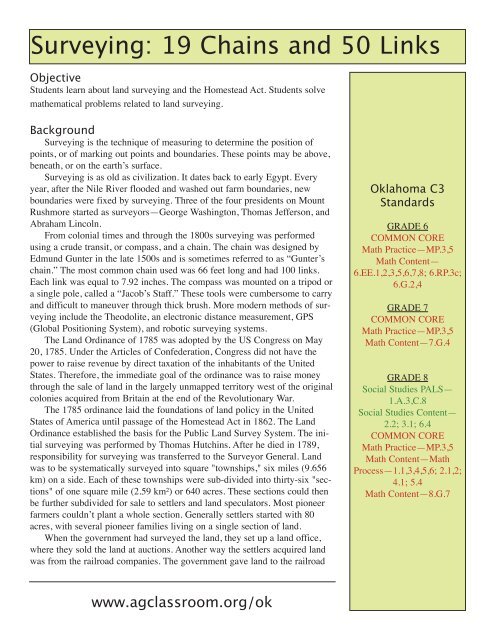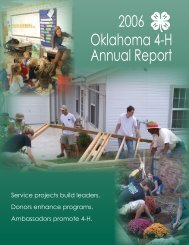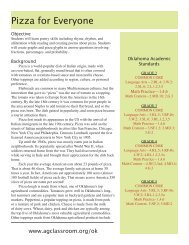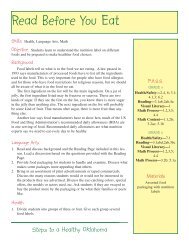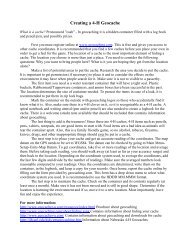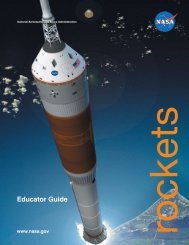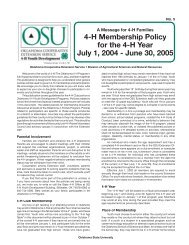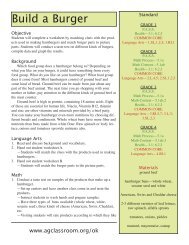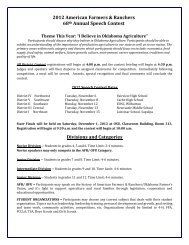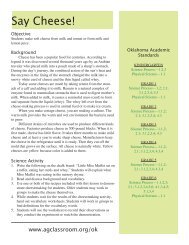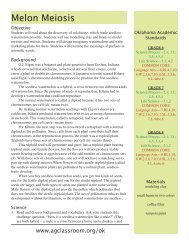Surveying: 19 Chains and 50 Links - Oklahoma 4-H
Surveying: 19 Chains and 50 Links - Oklahoma 4-H
Surveying: 19 Chains and 50 Links - Oklahoma 4-H
Create successful ePaper yourself
Turn your PDF publications into a flip-book with our unique Google optimized e-Paper software.
<strong>Surveying</strong>: <strong>19</strong> <strong>Chains</strong> <strong>and</strong> <strong>50</strong> <strong>Links</strong><br />
Objective<br />
Students learn about l<strong>and</strong> surveying <strong>and</strong> the Homestead act. Students solve<br />
mathematical problems related to l<strong>and</strong> surveying.<br />
Background<br />
<strong>Surveying</strong> is the technique of measuring to determine the position of<br />
points, or of marking out points <strong>and</strong> boundaries. These points may be above,<br />
beneath, or on the earth’s surface.<br />
<strong>Surveying</strong> is as old as civilization. It dates back to early egypt. every<br />
year, after the nile river flooded <strong>and</strong> washed out farm boundaries, new<br />
boundaries were fixed by surveying. Three of the four presidents on mount<br />
rushmore started as surveyors—George Washington, Thomas Jefferson, <strong>and</strong><br />
abraham Lincoln.<br />
From colonial times <strong>and</strong> through the 1800s surveying was performed<br />
using a crude transit, or compass, <strong>and</strong> a chain. The chain was designed by<br />
edmund Gunter in the late 1<strong>50</strong>0s <strong>and</strong> is sometimes referred to as “Gunter’s<br />
chain.” The most common chain used was 66 feet long <strong>and</strong> had 100 links.<br />
each link was equal to 7.92 inches. The compass was mounted on a tripod or<br />
a single pole, called a “Jacob’s Staff.” These tools were cumbersome to carry<br />
<strong>and</strong> difficult to maneuver through thick brush. more modern methods of surveying<br />
include the Theodolite, an electronic distance measurement, GPS<br />
(Global Positioning System), <strong>and</strong> robotic surveying systems.<br />
The L<strong>and</strong> ordinance of 1785 was adopted by the US Congress on may<br />
20, 1785. Under the articles of Confederation, Congress did not have the<br />
power to raise revenue by direct taxation of the inhabitants of the United<br />
States. Therefore, the immediate goal of the ordinance was to raise money<br />
through the sale of l<strong>and</strong> in the largely unmapped territory west of the original<br />
colonies acquired from Britain at the end of the revolutionary War.<br />
The 1785 ordinance laid the foundations of l<strong>and</strong> policy in the United<br />
States of america until passage of the Homestead act in 1862. The L<strong>and</strong><br />
ordinance established the basis for the Public L<strong>and</strong> Survey System. The initial<br />
surveying was performed by Thomas Hutchins. after he died in 1789,<br />
responsibility for surveying was transferred to the Surveyor General. L<strong>and</strong><br />
was to be systematically surveyed into square "townships," six miles (9.656<br />
km) on a side. each of these townships were sub-divided into thirty-six "sections"<br />
of one square mile (2.59 km²) or 640 acres. These sections could then<br />
be further subdivided for sale to settlers <strong>and</strong> l<strong>and</strong> speculators. most pioneer<br />
farmers couldn’t plant a whole section. Generally settlers started with 80<br />
acres, with several pioneer families living on a single section of l<strong>and</strong>.<br />
When the government had surveyed the l<strong>and</strong>, they set up a l<strong>and</strong> office,<br />
where they sold the l<strong>and</strong> at auctions. another way the settlers acquired l<strong>and</strong><br />
was from the railroad companies. The government gave l<strong>and</strong> to the railroad<br />
<strong>Oklahoma</strong> C3<br />
St<strong>and</strong>ards<br />
Grade 6<br />
Common Core<br />
math Practice—mP.3,5<br />
math Content—<br />
6.ee.1,2,3,5,6,7,8; 6.rP.3c;<br />
6.G.2,4<br />
Grade 7<br />
Common Core<br />
math Practice—mP.3,5<br />
math Content—7.G.4<br />
Grade 8<br />
Social Studies PaLS—<br />
1.a.3,C.8<br />
Social Studies Content—<br />
2.2; 3.1; 6.4<br />
Common Core<br />
math Practice—mP.3,5<br />
math Content—math<br />
Process—1.1,3,4,5,6; 2.1,2;<br />
4.1; 5.4<br />
math Content—8.G.7<br />
www.agclassroom.org/ok
Resources Needed<br />
ruler<br />
yard/meter sticks<br />
protractor<br />
calculator<br />
yarn/string<br />
construction stakes<br />
hammer<br />
10’ or 25’ measuring tool<br />
computer access<br />
companies to encourage them to build railroad lines in the new territories.<br />
The railroad companies would sell some of the l<strong>and</strong> to farmers.<br />
The 1785 ordinance also established a mechanism for funding public<br />
education. Section 16 in each township was reserved for the maintenance of<br />
public schools. many schools today are still located in section sixteen of their<br />
respective townships, although a great many of the school sections were sold<br />
to raise money for public education. In theory, the federal government also<br />
reserved sections 8, 11, 26 <strong>and</strong> 29 to compensate veterans of the<br />
revolutionary War, but examination of property abstracts in ohio indicates<br />
that this was not uniformly practiced. The Point of Beginning for the 1785<br />
survey was where ohio (as the easternmost part of the northwest Territory),<br />
Pennsylvania <strong>and</strong> Virginia (now West Virginia) met, on the north shore of the<br />
ohio river near east Liverpool, ohio. There is a historical marker just north<br />
of the site, at the state line where ohio route 39 becomes Pennsylvania<br />
route 68.<br />
In may of 1862, Congress passed the Homestead act. It provided that<br />
any person over 21 who was the head of a family <strong>and</strong> either a citizen or an<br />
alien who intended to become a citizen could obtain the title to 160 acres (65<br />
hectares) of public l<strong>and</strong> if he lived on the l<strong>and</strong> for five years <strong>and</strong> improved it.<br />
Settlers could also pay $1.25 per acre in place of the residence requirement.<br />
It was thought that the l<strong>and</strong> was worthless until improved, <strong>and</strong> homesteaders<br />
should not have to pay for the l<strong>and</strong> if they were willing to improve it by turning<br />
in into farms.<br />
The Homestead act attracted thous<strong>and</strong>s of settlers to the West. From<br />
1862 until <strong>19</strong>00, it provided farms <strong>and</strong> new homes for between 400,000 <strong>and</strong><br />
600,000 families. as families arrived, the federal government had to survey<br />
the l<strong>and</strong>.<br />
For “no man’s L<strong>and</strong>” <strong>and</strong> the “Unassigned L<strong>and</strong>s” of oklahoma, the<br />
Indian meridian <strong>and</strong> Indian Base Line were established at approximately<br />
twelve miles west of the 97th meridian. as provided in 1866, with treaties<br />
between the US government <strong>and</strong> the Choctaw <strong>and</strong> Chickasaw nation, Indian<br />
l<strong>and</strong> east of the 98th meridian was surveyed according to the public l<strong>and</strong> survey<br />
system of the US General L<strong>and</strong> office. established in 1785, this system<br />
of l<strong>and</strong> survey used a mathematically-determined method to divide the public<br />
domain into st<strong>and</strong>ard units called “sections.” From the Initial Point (Fort<br />
arbuckle—approximately six miles west of the present town of davis), a<br />
north-south line (Indian meridian) <strong>and</strong> east-west line (Indian Base) were<br />
drawn. eventually all the mapping <strong>and</strong> surveying would become boundary<br />
lines from which thous<strong>and</strong>s made the L<strong>and</strong> run of 1889 into the<br />
“Unassigned L<strong>and</strong>s” of oklahoma.<br />
Background Sources: Bradley, Harold W., “Homestead act,” World Book Encyclopedia;<br />
Straus, e. G., “Gunter ’s Chain,” World Book Encyclopedia; “L<strong>and</strong> ordinance of 1785,”<br />
Wikipedia, the free encyclopedia, http://en.wikipedia.org/wiki/L<strong>and</strong>_Ordinance_of_1785; “a<br />
Brief History of L<strong>and</strong> <strong>Surveying</strong>,” http://www.plsurvey.com; “<strong>Surveying</strong> L<strong>and</strong>,”<br />
http://www.campsilos.org; Chapman, Berlin B., Indian Meridian, archives <strong>and</strong> manuscripts<br />
division, oklahoma Historical Society, <strong>19</strong>67.<br />
www.agclassroom.org/ok
Activities<br />
1. read together <strong>and</strong> discuss the background information to familiarize students<br />
with surveying <strong>and</strong> its purpose.<br />
—Students will give examples of the uses of surveying today.<br />
—Introduce/discuss the vocabulary.<br />
2. discuss the Homestead act of 1862.<br />
—Were the original purposes for the Homestead act successful?<br />
—What problems or concerns arose?<br />
3. H<strong>and</strong> out Worksheet a <strong>and</strong> review with students.<br />
—discuss the terminology of measurement used in surveying.<br />
—Compare the measurements to st<strong>and</strong>ard or metric units used today.<br />
—Students complete Worksheet a using the information given.<br />
—discuss the problems or concerns students had relating to the conversion<br />
of measurements.<br />
4. H<strong>and</strong> out Worksheet B <strong>and</strong> review with students.<br />
—discuss the surveying terminology of townships <strong>and</strong> sections.<br />
—divide students into groups of three or four.<br />
—Students will work together to complete the surveying.<br />
—Students will complete Worksheet B, using their geometric skills to<br />
physically stake out plots on the school grounds.<br />
—Students will use protractors to accurately find the angles on their<br />
plots.<br />
—Students will exchange work areas with another group <strong>and</strong> check the<br />
accuracy of that group’s survey work.<br />
—discuss the problems of physically completing this activity rather than<br />
doing it on paper.<br />
—What would have been some problems with surveying l<strong>and</strong> in the early<br />
1800s?<br />
Extra Reading<br />
Harlan, James d., <strong>and</strong> James m. denny, Atlas of Lewis <strong>and</strong> Clark in<br />
Missouri, University of missouri, 2003.<br />
Lasky, Kathryn, The Journal of Augustus Pelletier: The Lewis <strong>and</strong> Clark<br />
Expedition (My Name is America), Scholastic, 2000.<br />
Laurence, edward, The Young Surveyor’s Guide: Or, a New Introduction to<br />
the Whole Art of <strong>Surveying</strong> L<strong>and</strong>: Both by the Chain <strong>and</strong> all<br />
Instruments Now in Use, nabu, 2010.<br />
macLauchlan, Patricia, Caleb’s Story, HarperTrophy, 2002.<br />
Panchyk, richard, Keys to American History: Underst<strong>and</strong>ing Our Most<br />
Important Historic Documents, Chicago review, 2009.<br />
Petersen, Christine, Colonial People: The Surveyor, Benchmark, 2010<br />
Vocabulary<br />
boundary—anything marking<br />
a limit or border<br />
chain—a 66 foot length in<br />
surveying made up of 100<br />
links<br />
compass—instrument for<br />
showing direction by using<br />
a magnetic needle which<br />
always points north<br />
domain—l<strong>and</strong> or territory<br />
belonging to one government<br />
or person<br />
Global Positioning System<br />
(GPS)—a system of satellites,<br />
computers, <strong>and</strong><br />
receivers that is able to<br />
determine the latitude <strong>and</strong><br />
longitude of a receiver on<br />
earth by calculating the<br />
time difference for signals<br />
from different satellites to<br />
reach the receiver<br />
hectare—metric measure<br />
of surface equal to 10,000<br />
square meters or 2.471<br />
acres<br />
meridian—any of the lines<br />
of longitude running north<br />
<strong>and</strong> south on a map or<br />
globe<br />
robotic—an automated<br />
device to take the place of<br />
human manual work<br />
transit—a surveying<br />
instrument for measuring<br />
horizontal angles<br />
www.agclassroom.org/ok
name _______________________________<br />
<strong>Surveying</strong>: <strong>19</strong> <strong>Chains</strong> <strong>and</strong> <strong>50</strong> <strong>Links</strong> A<br />
<strong>Surveying</strong> units:<br />
Chain = 66ft. or 20 meters (100 links)<br />
Furlong/furrowlong = 660 ft.<br />
Link = 7.92 inches<br />
mile = 5280 ft. or 1760 yds.<br />
rod/perch/Jacob’s pole = 16.5 feet<br />
Township = square of l<strong>and</strong> 6 miles by 6 miles<br />
80 chains = 1 mile Township = 36 sections<br />
100 square chains = 10 acres square Section = 640 acres or 1 mile square<br />
1 chain = the width of many rural roads<br />
Use the above information to complete the activities below. Please show your computations.<br />
1. draw a township, including the 36 sections. (.25 inches = 1 mile)<br />
2. most early settlers could only farm 80 acres. How many 80-acre plots are included in a township?<br />
3. a Jacob’s pole is 3 fathoms or 16.5 feet long.<br />
a. How many poles would equal 1 chain?<br />
b. How many links would equal one pole?<br />
4. Surveyors used stakes to mark the end of each chain. If they were surveying a square plot of 10 acres per<br />
side, how many stakes would they need?<br />
5. How many chain lengths would be needed to survey a township? (perimeter measurement)<br />
6. How many chains <strong>and</strong> links would be needed to plot a distance of 8000 feet?<br />
oklahoma ag in the Classroom is a program of the oklahoma Cooperative extension Service, the oklahoma<br />
department of agriculture, Food <strong>and</strong> Forestry <strong>and</strong> the oklahoma State department of education.
<strong>Surveying</strong>: <strong>19</strong> <strong>Chains</strong> <strong>and</strong> <strong>50</strong> <strong>Links</strong> (answers)<br />
name _________________________<br />
<strong>Surveying</strong> units:<br />
Chain = 66ft. or 20 meters (100 links)<br />
Furlong/furrowlong = 660 ft.<br />
Link = 7.92 inches<br />
mile = 5280 ft. or 1760 yds.<br />
rod/perch/Jacob’s pole = 16.5 feet<br />
Township = square of l<strong>and</strong> 6 miles by 6 miles<br />
80 chains = 1 mile Township = 36 sections<br />
100 square chains = 10 acres square Section = 640 acres or 1 mile square<br />
1 chain = the width of many rural roads<br />
Use the above information to complete the activities below. Please show your computations.<br />
1. draw a township, including the 36 sections. (.25 inches = 1 mile)<br />
answer: each side of the township should measure 1 1/2 inches.<br />
2. most early settlers could only farm 80 acres. How many 80-acre plots are included in a township?<br />
answer: each section = 640 acres ÷80 acres = 8 farm plots<br />
36 sections (1 township) x 8 farms = 288 plots<br />
3. a Jacob’s pole is 3 fathoms or 16.5 feet long.<br />
a. How many poles would equal 1 chain?<br />
answer: 1 chain = 66 ft.<br />
66 ft. ÷ 16.5 ft. = 4 poles<br />
b. How many links would equal one pole?<br />
answer: 1 link = 7.92 in 1 pole = 16.5 ft. or <strong>19</strong>8 in.<br />
<strong>19</strong>8 in. ÷ 7.92 in. = 25 links<br />
4. Surveyors used stakes to mark the end of each chain. If they were surveying a square plot of 10 acres per<br />
side, how many stakes would they need?<br />
answer: 10 chains per side<br />
4 corner stakes + 9 stakes per side<br />
9 stakes x 4 sides + 4 corners = 40 stakes<br />
5. How many chain lengths would be needed to survey a township? (perimeter measurement)<br />
answer: 80 chains per mile 6 miles x 4 sides = 24 miles perimeter<br />
24 miles x 80 chains = <strong>19</strong>20 chain lengths<br />
6. How many chains <strong>and</strong> links would be needed to plot a distance of 8000 feet?<br />
answer: 1 chain = 66 ft.<br />
8000 ft. ÷ 66 ft = 7986 ft. (121 chains)<br />
8000 – 7986 = 14 ft. or 168 inches<br />
168 in ÷ 7.92 in = 21.21 links<br />
Final answer: 121 chains <strong>and</strong> 21.21 link<br />
A<br />
oklahoma ag in the Classroom is a program of the oklahoma Cooperative extension Service, the oklahoma<br />
department of agriculture, Food <strong>and</strong> Forestry <strong>and</strong> the oklahoma State department of education.
name _________________________<br />
<strong>Surveying</strong>: <strong>19</strong> <strong>Chains</strong> <strong>and</strong> <strong>50</strong> <strong>Links</strong> B<br />
as a surveyor, you will be marking out sections of l<strong>and</strong>. all angles <strong>and</strong> measurements need to be exact.<br />
1. Survey a square plot of l<strong>and</strong> with sides of 25 links. (a link equals 7.92 inches.) draw <strong>and</strong> label your plot<br />
when finished surveying.<br />
2. Survey a triangular plot of l<strong>and</strong>. The plot forms a right triangle whose base is 3 ft. long <strong>and</strong> contains a 60-<br />
degree angle. draw <strong>and</strong> label your plot when finished with the measurements of all three sides <strong>and</strong> angles.<br />
3. Your choice! Complete the survey of a plot which is a geometric polygon <strong>and</strong> has 6 or fewer sides. Be<br />
sure to draw <strong>and</strong> label a diagram of your plot with angles <strong>and</strong> sides.<br />
oklahoma ag in the Classroom is a program of the oklahoma Cooperative extension Service, the oklahoma<br />
department of agriculture, Food <strong>and</strong> Forestry <strong>and</strong> the oklahoma State department of education.
<strong>Surveying</strong>: <strong>19</strong> <strong>Chains</strong> <strong>and</strong> <strong>50</strong> <strong>Links</strong> (answers)<br />
name _________________________<br />
B<br />
as a surveyor, you will be marking out sections of l<strong>and</strong>. all angles <strong>and</strong> measurements need to be exact.<br />
1. Survey a square plot of l<strong>and</strong> with sides of 25 links. (a link equals 7.92 inches.) draw <strong>and</strong> label your plot<br />
when finished surveying.<br />
answer: 25 links x 7.92 in = <strong>19</strong>8 inches or 16.5 ft. or 5.5 yds<br />
drawing: a square with 90 degree angles<br />
2. Survey a triangular plot of l<strong>and</strong>. The plot forms a right triangle whose base is 3 ft. long <strong>and</strong> contains a 60<br />
degree angle. draw <strong>and</strong> label your plot when finished with the measurements of all 3 sides <strong>and</strong> angles.<br />
answer: The angles of the right triangle should be 30, 60, <strong>and</strong> 90 degrees respectively.<br />
The sides of the triangle should follow the formula 3 squared + “b” squared = “c” squared with “c” being<br />
the hypotenuse of the triangle.<br />
3. Your choice! Complete the survey of a plot which is a geometric polygon <strong>and</strong> has 6 or fewer sides. Be<br />
sure to draw <strong>and</strong> label a diagram of your plot with angles <strong>and</strong> sides.<br />
answers: each group will vary depending on the choice of design.<br />
oklahoma ag in the Classroom is a program of the oklahoma Cooperative extension Service, the oklahoma<br />
department of agriculture, Food <strong>and</strong> Forestry <strong>and</strong> the oklahoma State department of education.


